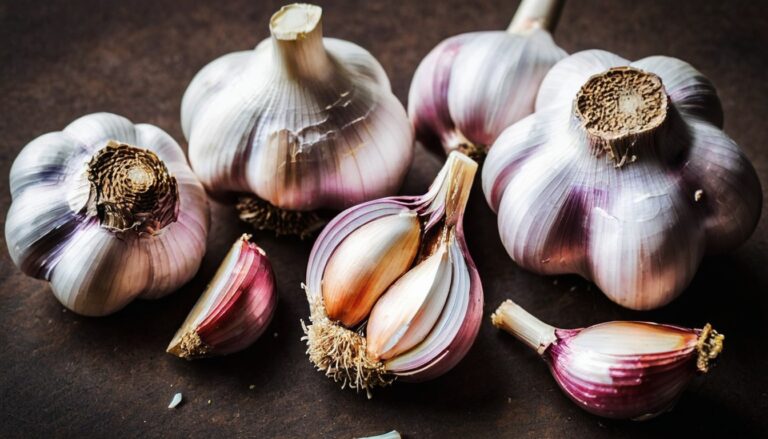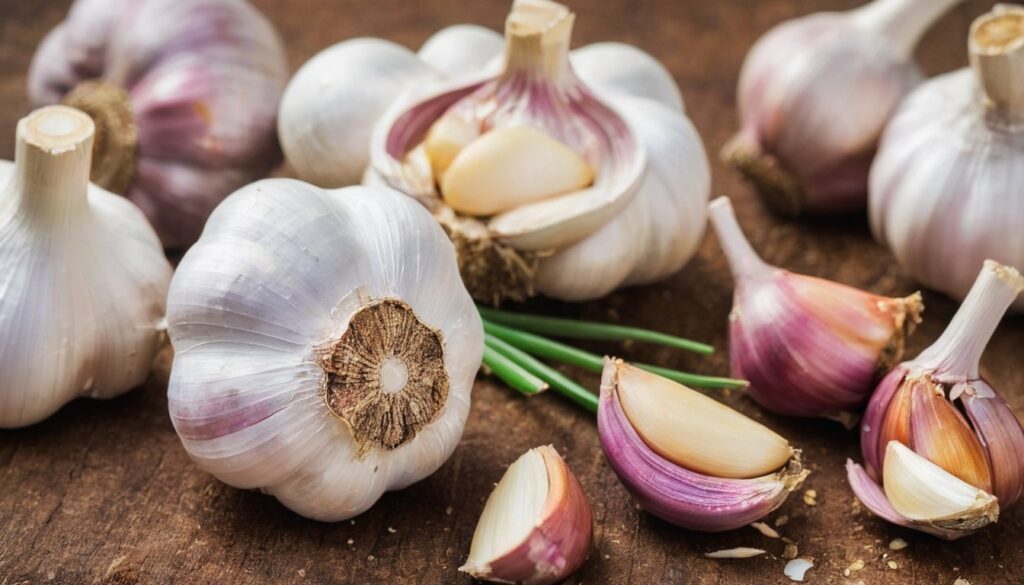Brief overview of garlic as a versatile ingredient in culinary and medicinal practices:
Garlic, with its pungent aroma and distinct flavor, has been a staple ingredient in kitchens worldwide for centuries. Beyond its culinary uses, garlic has also been highly valued for its medicinal properties in various traditional healing systems. From ancient civilizations to modern-day households, garlic has earned a reputation as a potent natural remedy for a myriad of health ailments.
Introduce the concept of garlic as a natural antibiotic:
One of the most notable medicinal properties of garlic is its ability to act as a natural antibiotic. Unlike synthetic antibiotics, which can sometimes lead to antibiotic resistance and other adverse effects, garlic offers a gentler yet effective alternative. Through its rich array of bioactive compounds, garlic exerts antimicrobial effects that can help combat a wide range of bacterial, viral, and fungal infections.
In this comprehensive guide, we will delve into the fascinating world of garlic as a natural antibiotic. From its historical use as a medicinal herb to its scientifically-proven health benefits, we will explore how garlic can serve as your ultimate defense against infections. Throughout the post, we will uncover the mechanisms behind garlic’s antibiotic properties and discuss its various health benefits, including its role in fighting common infections, supporting gut health, boosting the immune system, and promoting overall well-being. Whether you’re a seasoned garlic enthusiast or someone curious about its healing potential, join us on this journey to unlock the secrets of garlic’s antibiotic power.

Garlic: A Nutritional Powerhouse
Overview of garlic’s nutritional profile:
Garlic is not only renowned for its distinct flavor but also for its impressive nutritional composition. This humble bulb packs a powerful punch of essential nutrients, making it a valuable addition to any diet. Among its notable components are high levels of allicin, sulfur compounds, vitamins, and minerals. Allicin, in particular, is a sulfur-containing compound responsible for many of garlic’s health-promoting properties.
- High levels of allicin, sulfur compounds, vitamins, and minerals:
Allicin, formed when garlic is chopped, crushed, or chewed, is one of garlic’s primary bioactive compounds. It is renowned for its potent antibacterial, antiviral, and antifungal properties. Additionally, garlic contains sulfur compounds like diallyl disulfide and diallyl trisulfide, which contribute to its characteristic odor and also possess various health benefits. In terms of vitamins and minerals, garlic is rich in vitamin C, vitamin B6, manganese, and selenium, among others, all of which play crucial roles in maintaining overall health and well-being.
Importance of allicin in garlic for its antibiotic properties:
Allicin is the star player when it comes to garlic’s antibiotic properties. This compound is formed from the precursor alliin when garlic is crushed or chopped, triggering a chemical reaction mediated by the enzyme alliinase. Allicin is highly volatile and unstable, but it is also incredibly potent against a wide range of pathogens, including bacteria, viruses, and fungi. Its ability to disrupt microbial cell membranes and inhibit vital enzymes makes it an effective natural antibiotic without the risk of inducing antibiotic resistance.
Other bioactive compounds contributing to garlic’s health benefits:
While allicin takes the spotlight for its antibiotic properties, garlic contains a plethora of other bioactive compounds that contribute to its overall health benefits. These include sulfur compounds like diallyl sulfides, which have been shown to have antioxidant and anti-inflammatory effects. Additionally, garlic contains flavonoids, phenolic acids, and saponins, all of which possess various biological activities that support health and wellness. Together, these compounds work synergistically to enhance garlic’s therapeutic potential and make it a true nutritional powerhouse.
Understanding the nutritional profile of garlic and the role of key bioactive compounds like allicin sheds light on why this humble herb has been revered for its medicinal properties for centuries. In the next sections, we will delve deeper into how garlic’s antibiotic properties translate into tangible health benefits for combating infections and promoting overall well-being.
Garlic as Nature’s Antibiotic
Exploring garlic’s historical use as a medicinal herb:
Garlic’s medicinal use dates back thousands of years, with evidence of its therapeutic properties found in ancient Egyptian, Greek, Roman, and Chinese civilizations. Throughout history, garlic has been employed to treat various ailments, ranging from infections and digestive disorders to respiratory conditions and even as a remedy for parasites. Its widespread use across different cultures underscores its enduring reputation as a potent medicinal herb.
How allicin works as a natural antibiotic:
Inhibition of bacterial growth and biofilm formation: Allicin, the key bioactive compound in garlic, exerts its antibiotic effects through multiple mechanisms. One of its primary actions is the inhibition of bacterial growth by disrupting essential cellular processes. Allicin targets the cell membranes of bacteria, causing structural damage and compromising their integrity. This disruption leads to cell death and inhibits the proliferation of harmful bacteria. Moreover, allicin has been shown to interfere with the formation of bacterial biofilms, which are protective layers that allow bacteria to adhere to surfaces and evade immune responses. By preventing biofilm formation, allicin enhances the effectiveness of antibiotics and immune defenses against bacterial infections.
Enhancement of immune function: In addition to its direct antimicrobial effects, allicin also modulates the immune system, enhancing its ability to combat infections. Allicin stimulates the activity of immune cells, such as macrophages and lymphocytes, which play crucial roles in recognizing and eliminating pathogens. By boosting immune function, garlic helps the body mount a robust defense against invading microbes, thereby reducing the risk of infection and promoting faster recovery.
Comparison between garlic and conventional antibiotics:
Effectiveness: Garlic’s effectiveness as an antibiotic has been demonstrated in numerous studies, showing efficacy against a wide range of bacterial, viral, and fungal pathogens. Unlike conventional antibiotics, which often target specific bacterial strains and can lead to the development of antibiotic resistance, garlic exhibits broad-spectrum antimicrobial activity without promoting resistance. Furthermore, garlic’s multifaceted approach to combating infections, including its ability to enhance immune function and disrupt biofilms, makes it a valuable adjunct to conventional antibiotic therapy.
Side effects and safety profile: One of the advantages of garlic as a natural antibiotic is its favorable safety profile compared to synthetic antibiotics. While conventional antibiotics may cause adverse effects such as gastrointestinal upset, allergic reactions, and antibiotic-associated diarrhea, garlic is generally well-tolerated when consumed in moderate amounts. However, excessive consumption of garlic or garlic supplements may lead to digestive discomfort, heartburn, and in rare cases, allergic reactions. It is essential to use garlic responsibly and consult healthcare professionals for personalized recommendations, especially for individuals with underlying health conditions or taking medications.
Scientific evidence supporting garlic’s antibiotic properties:
Research studies and clinical trials: Numerous scientific studies have investigated the antimicrobial properties of garlic and its constituents, providing compelling evidence of its efficacy against various pathogens. Clinical trials have demonstrated garlic’s effectiveness in treating respiratory infections, gastrointestinal infections, skin conditions, and urinary tract infections, among others. These studies highlight the potential of garlic as a natural alternative to conventional antibiotics for managing infections and promoting health.
Testimonials from users: Beyond scientific research, anecdotal evidence from individuals who have incorporated garlic into their wellness routines further supports its antibiotic properties. Many people report experiencing relief from infections and improved immune function after regularly consuming garlic or garlic supplements. While testimonials may not provide definitive proof of garlic’s efficacy, they offer valuable insights into its real-world applications and therapeutic benefits.
Garlic’s long history of medicinal use, coupled with modern scientific research, underscores its role as nature’s antibiotic. By harnessing the power of allicin and other bioactive compounds, garlic offers a natural and effective solution for combating infections and supporting overall health. In the following sections, we will delve into the specific health benefits of garlic as a natural antibiotic and explore practical ways to incorporate it into your daily routine.

Health Benefits of Garlic as a Natural Antibiotic
Fighting Common Infections:
Cold and flu: Garlic’s potent antimicrobial properties make it a valuable ally in the battle against colds and flu. Its ability to inhibit viral replication and enhance immune function can help shorten the duration and severity of symptoms associated with respiratory infections. Consuming garlic regularly, especially at the onset of symptoms, may help alleviate congestion, coughing, and sore throat commonly experienced during cold and flu season.
Sore throat: Garlic’s antibacterial and anti-inflammatory properties make it an effective remedy for soothing sore throats. Gargling with a mixture of crushed garlic and warm water can help reduce inflammation, kill bacteria, and provide temporary relief from discomfort. Additionally, consuming garlic orally may help address the underlying cause of throat infections, promoting faster healing and symptom relief.
Sinus infections: Sinus infections, characterized by inflammation and congestion in the nasal passages, can be alleviated with the help of garlic. Garlic’s antimicrobial and decongestant properties help clear nasal passages, reduce inflammation, and inhibit bacterial growth. Whether consumed orally or used topically as a nasal spray or steam inhalation, garlic can provide relief from sinus pressure, congestion, and pain associated with sinus infections.
Supporting Gut Health:
Balancing gut microbiota: Garlic contains prebiotic fibers and compounds that support the growth of beneficial gut bacteria, thereby promoting a healthy balance of gut microbiota. By nourishing the gut microbiome, garlic helps improve digestion, enhance nutrient absorption, and strengthen the gut barrier function. This can contribute to overall gastrointestinal health and reduce the risk of digestive disorders such as irritable bowel syndrome (IBS) and inflammatory bowel disease (IBD).
Alleviating digestive issues: Garlic’s digestive benefits extend beyond supporting gut microbiota to alleviating various digestive issues. Its anti-inflammatory properties can help soothe inflammation in the digestive tract, while its antimicrobial effects combat harmful bacteria that may contribute to gastrointestinal infections and dysbiosis. Consuming garlic regularly may help alleviate symptoms of indigestion, bloating, gas, and diarrhea, promoting overall digestive comfort and well-being.
Boosting Immune System:
Stimulating immune response: Garlic is renowned for its immune-boosting properties, thanks to its ability to stimulate the activity of immune cells and enhance immune response. Allicin and other bioactive compounds in garlic support the production and function of immune cells, including white blood cells, which play a critical role in defending the body against infections. By strengthening the immune system, garlic helps reduce the risk of illness and supports faster recovery from infections.
Preventing recurrent infections: Regular consumption of garlic may help prevent recurrent infections by bolstering the immune system and inhibiting the growth of pathogens. Whether it’s colds, flu, urinary tract infections, or gastrointestinal infections, garlic’s antimicrobial properties can help reduce the frequency and severity of recurrent infections. Additionally, garlic’s ability to enhance immune function provides long-term protection against various pathogens, minimizing the risk of reinfection.
Promoting Overall Well-being:
Antioxidant properties: Garlic is rich in antioxidants, including vitamin C, selenium, and various sulfur compounds, which help neutralize harmful free radicals and protect cells from oxidative damage. By scavenging free radicals, garlic helps reduce the risk of chronic diseases, slow down the aging process, and promote overall cellular health. Incorporating garlic into your diet can contribute to a healthier, more resilient body.
Cardiovascular health benefits: Garlic has long been celebrated for its cardiovascular health benefits, including its ability to lower blood pressure, reduce cholesterol levels, and improve blood circulation. Allicin and other sulfur compounds in garlic help relax blood vessels, reduce inflammation, and prevent the formation of blood clots, thereby reducing the risk of heart disease, stroke, and other cardiovascular disorders. Regular consumption of garlic as part of a heart-healthy diet can help support cardiovascular health and reduce the risk of cardiovascular events.
By harnessing the health benefits of garlic as a natural antibiotic, you can support your body’s defense against infections, promote digestive health, boost immune function, and enhance overall well-being. In the next section, we will explore practical tips for incorporating garlic into your daily routine and maximizing its therapeutic potential.

Incorporating Garlic into Your Daily Routine
Tips for maximizing garlic’s health benefits:
Proper storage and preparation techniques: To preserve garlic’s potency and maximize its health benefits, it’s essential to store it properly and prepare it correctly. Store garlic bulbs in a cool, dark place with good air circulation, such as a pantry or cupboard. Avoid storing garlic in the refrigerator, as the cold temperature can cause it to sprout and lose flavor. When preparing garlic, chop, crush, or mince it and let it sit for a few minutes before cooking to activate the enzyme alliinase and maximize the production of allicin, the compound responsible for many of garlic’s health-promoting properties.
Recommended dosage: While there is no specific recommended dosage for garlic, incorporating it into your daily diet can provide a range of health benefits. Aim to consume at least one to two cloves of fresh garlic per day to reap its immune-boosting and antibiotic effects. If using garlic supplements, follow the dosage recommendations on the product label and consult with a healthcare professional for personalized advice, especially if you have underlying health conditions or are taking medications.
Creative ways to include garlic in meals and recipes:
Cooking techniques and flavor pairings: Garlic adds depth and complexity to a wide range of dishes, from soups and stews to stir-fries and sauces. Experiment with different cooking techniques, such as sautéing, roasting, or grilling, to bring out garlic’s unique flavors. Pair garlic with complementary ingredients like herbs (e.g., parsley, basil, thyme), spices (e.g., cumin, paprika, chili flakes), and acidic ingredients (e.g., lemon juice, vinegar) to enhance its taste and aroma. Incorporate minced garlic into marinades, dressings, and dips for added flavor and nutritional benefits.
Garlic supplements as an alternative option: If you’re not fond of the taste or aroma of fresh garlic, or if you’re looking for a convenient way to incorporate garlic into your daily routine, consider taking garlic supplements. Garlic supplements are available in various forms, including capsules, tablets, and extracts, and can provide a concentrated dose of garlic’s active compounds. Look for supplements standardized to contain allicin or alliin, the key bioactive components in garlic, and choose reputable brands that adhere to quality standards. However, keep in mind that supplements should complement a balanced diet rich in whole foods rather than replace it entirely.
Incorporating garlic into your daily routine doesn’t have to be complicated. By following these tips for maximizing garlic’s health benefits and getting creative with your culinary creations, you can enjoy the immune-boosting, antibiotic properties of garlic while enhancing the flavor and nutritional value of your meals. Experiment with different recipes, cooking techniques, and supplement options to find what works best for you and make garlic a delicious and nutritious part of your daily diet.
Precautions and Considerations
Potential side effects and interactions:
While garlic offers numerous health benefits, it’s essential to be aware of potential side effects and interactions, especially when consumed in large quantities or in supplement form. Some individuals may experience digestive discomfort, such as heartburn, gas, or bloating, after consuming garlic, particularly raw garlic. Additionally, garlic may interact with certain medications, including blood thinners, HIV/AIDS medications, and some types of chemotherapy drugs. If you’re taking medication or have a pre-existing health condition, consult with your healthcare provider before adding garlic to your diet or taking garlic supplements to avoid potential adverse effects or interactions.
B. Consultation with healthcare professionals:
Before making any significant changes to your diet or lifestyle, it’s advisable to consult with a qualified healthcare professional, such as a physician, registered dietitian, or naturopathic doctor. They can provide personalized recommendations based on your individual health status, medical history, and specific needs. If you’re considering incorporating garlic into your daily routine for its health benefits, discuss your intentions with your healthcare provider to ensure it’s safe and appropriate for you, especially if you have underlying health conditions or are taking medications that may interact with garlic.
C. Allergy considerations:
While rare, some individuals may be allergic to garlic or other members of the Allium family, such as onions, leeks, and shallots. Garlic allergy symptoms may include skin rash, itching, swelling, or difficulty breathing, and can range from mild to severe. If you suspect you may have a garlic allergy or experience any adverse reactions after consuming garlic, seek medical attention immediately. If you have a known allergy to garlic or other Allium vegetables, avoid consuming garlic and products containing garlic altogether to prevent allergic reactions.
It’s essential to exercise caution and take appropriate precautions when incorporating garlic into your daily routine, especially if you have underlying health conditions, are pregnant or breastfeeding, or are taking medications. While garlic can offer significant health benefits when consumed responsibly, it’s essential to be mindful of potential risks and consult with healthcare professionals to ensure safe and appropriate use. By taking a proactive approach to your health and seeking expert guidance, you can enjoy the immune-boosting and antibiotic properties of garlic while minimizing potential risks and maximizing its therapeutic potential.

Conclusion
Recap of the health benefits of garlic as a natural antibiotic:
Throughout this comprehensive guide, we’ve explored the myriad health benefits of garlic as a natural antibiotic. From its historical use as a medicinal herb to its scientifically-proven antimicrobial properties, garlic has earned its reputation as a potent ally in the fight against infections. Its ability to combat common ailments such as colds, flu, sore throats, and sinus infections, as well as its role in supporting gut health, boosting immune function, and promoting overall well-being, highlights its versatility and efficacy as a natural remedy.
As you embark on your journey to better health, I encourage you to consider incorporating garlic into your daily regimen. Whether you choose to enjoy it in your favorite recipes, as a supplement, or as a natural remedy for common ailments, garlic can be a valuable addition to your wellness routine. By harnessing the immune-boosting and antibiotic properties of garlic, you can support your body’s natural defenses and enhance your overall health and vitality.
Closing thoughts on the importance of natural remedies for health maintenance:
In an era dominated by pharmaceutical drugs and synthetic treatments, the value of natural remedies cannot be overstated. Garlic, with its centuries-old history as a medicinal herb, serves as a powerful reminder of the healing potential of nature’s bounty. By embracing natural remedies like garlic, we can take proactive steps towards health maintenance and disease prevention while reducing reliance on conventional medications and their potential side effects. Let us not forget the wisdom of our ancestors, who turned to the earth’s gifts for healing, and let us continue to explore the vast array of natural remedies available to us for optimal health and well-being.
In conclusion, garlic stands as a shining example of nature’s ability to provide powerful solutions for our health needs. By recognizing and harnessing its potent antibiotic properties, we can empower ourselves to take control of our health and vitality. So, why not start incorporating garlic into your daily routine today and experience the transformative benefits it has to offer? Your body will thank you for it.

Nutrition Blogger
I am a Health/Wellness and Nutrition Blogger. Bringing you well-researched details on your nutrition and health information. I love Helping you enjoy good health with the right choice of food.
Disclaimer
The information provided on this page is intended for general informational purposes only and was gathered by research on general nutrition science and experiments. The content is not intended to be a substitute for your specific professional medical, nutritional, or fitness advice, diagnosis, or treatment.
Recent Posts
- 7 Surprising Reasons Why You Need a Balanced Diet Every Day as a Woman
- The Mediterranean Diet and Dementia: Protecting Brain Health
- Superfoods for Brain Health: Diet To Fight Dementia
- Nutritional Strategies for Managing Dementia Symptoms
- How To Recognize Early Signs and Symptoms of Dementia
- Managing Lewy Body Dementia: Understanding Symptoms and Nutrition
- Understanding Vascular Dementia: Causes, Symptoms, and Dietary Solutions
- Alzheimer’s Disease and The Right Diet: All You Need To Know
- Dementia vs. Normal Aging: Debunking Myths and Clarifying Realities
- What are The Risk Factors for Dementia?
- Dementia And Omega 3 Fatty Acid ( Eicosapentaenoic acid )
- The Role of Nutrition in Dementia Prevention
- Dementia: An Introduction to the Condition and Management
- Okra Extract Supplements: A Nutrient-Rich Addition to Your Wellness Routine
- Okra and Eye Health: Okra and Vitamin A for Clear Vision
- Fuel Your Fitness: Okra’s Role in Sustaining Energy and Enhancing Muscle Recovery
- Age Gracefully with Okra: Supporting Joint Health in the Elderly
- Slim Down with Okra: Low-Calorie Smoothie Recipes
- Why Okra is a Must-Have for Pregnant Mom: The Folate Advantage
- DIY Beauty: Okra-Based Face Masks for Radiant Skin
- Boosting Milk Supply: The Okra Advantage for Nursing Moms
- Boost Your Child’s Growth with Okra: A Nutrient-Packed Superfood
- How Okra Supports Cycle Regularity: The Menstrual Miracle
- Boosting Testosterone Naturally: The Role of Okra in Men’s Health
- Detox Delight: How Okra Supports Your Body’s Natural Cleansing Process
- How Okra Fights Cancer: Okra and Cancer Prevention
- Explore 10 Health Benefits Of Garlic: A Comprehensive Guide
- Health Benefits of Garlic for Fighting Cough and Cold Infections
- Can Garlic Be Used As a Natural Antibiotic?
- How Effective is Garlic in Lowering Cholesterol And Improving Heart Health?
- Garlic’s Brain Boost: Protecting Against Alzheimer’s and Dementia
- Garlic: Your Gut’s Best Friend – Enhance Digestion Naturally
- Unveiling the Immune-Boosting Powers of Garlic
- Using Garlic to Lighten Acne Scars Naturally: Skin Nutrition
- Beating Ulcers Naturally: The Garlic Solution
- Adding Garlic to Your Athletic Nutrition Routine.
- Garlic vs. UTI: Natural Remedy for Urinary Tract Infections
- How to Combat Exercise Fatigue with Garlic: The Science Behind it
- The Power of Garlic: Safely Reducing Blood Toxicity
- Garlic: A Natural Solution for Oestrogen Deficiency
- Garlic’s Role in Osteoarthritis Management: A Natural Remedy for Joint Health
- Platelet Power: Garlic’s Role in Preventing Heart Blockages
- Harnessing Garlic’s Power: 5 Health Benefits You Need to Know
- Unlocking the Secrets of Garlic in Preventing Thromboembolism
- Unlocking Garlic’s Potential: A Natural Approach to Lowering Blood Pressure
- Boosting Men’s Wellness: The Power of Garlic
- Explore The Incredible Benefits of Garlic for Women’s Health
- Treating Throat Disorders Naturally with Papaya
- Can Papaya Be Used Treatment For Ringworm?
- Can Cucumber Reduce the Risk of Cancer?
- Using Cucumber to Reduce Puffiness Around The Eyes.
- Using Cucumber For a Better Skin: Beauty Benefits of Cucumber.
- Are Cucumbers Helpful in Weight Loss?
- Can Cucumber Help Reduce Blood Sugar and Manage Diabetes?
- How can I improve my digestion with Cucumber?
- Unveiling Cucumbers’ Secrets for Hair and Nails: From Salad Bowl to Beauty Regimen
- Can Papaya Help Treat Piles? Hemorrhoids Natural Relief.
- Refreshing Solutions: Cucumbers for Bad Breath.
- Can Cucumber Help Regulate Blood Pressure?
- Cucumber: A Good Choice for Hydration and Detoxification
- How Papaya Can Help Reduce Lung Inflammation: Insights and Practical Tips
- Seniors’ Secret Weapon: Harnessing Cinnamon’s Health Benefits
- Transform Your Routine: Cinnamon for Beauty
- Discovering the Benefits of Cinnamon for Oral Hygiene
- Boost Your Workout: How Cinnamon Fuels Athletes.
- Unlocking the Weight Loss Potential of Cinnamon: A Comprehensive Guide
- Let’s Discuss Cinnamon Consumption During Pregnancy.
- Spicing Up Motherhood: Cinnamon Benefits for Nursing Moms
- Spice Up Your Child’s Diet: Fun Ways to Include Cinnamon in Meals
- Cinnamon: A Natural Remedy for Women’s Menstrual Health
- Using Cinnamon as a Natural Aphrodisiac: The Role of Cinnamon in the Infertility treatment and Sexual drive.
- Can Cinnamon Be Used in Treating Erectile Dysfunction?
- Can Eating Papaya Help Prevent Arthritis?
- Does papaya have Anticancer Effects?
- Can papaya Aids Digestion?
- Can Papaya Seeds Help Heal Wounds?
- How To Use Okra To Lose Weight and Reduce Belly Fat.
- How To Use Okra to Improve Capillaries Function.
- Can Okra Help Maintain a Healthy Heart and Prevent Heart Disease?
- Can Okra Help Prevent Constipation?
- How Can Okra Help Get Rid of Cholesterol?
- Can Okra Help Stabilize Blood Sugar and Prevent Diabetes?
- The Beauty Benefits of Okra for Hair, Skin, and Nails.
- How Okra Can Boost Women’s Health and Wellness.
- How Okra Can Boost Men’s Health: Unlocking the Nutritional Power of this Versatile Vegetable
- Different Ways to Include Okra to Your Diet
- Okra: Your Delicious Pathway to Vibrant Health and Culinary Delight!
- How Does Eating Papaya Boost Immunity?
- Preventing Macular Degeneration with Papaya. : Maintaining A Healthy Eye Vision
- Can Papaya Promotes Cardiovascular Health?
- How To Use Papaya To Condition Your Hair.
- Can Papaya Help in Controlling Dandruff?
- Can Papaya Stimulates Hair Growth?
- The Cognitive Benefits of Cloves for Brain Health.
- Can Cloves Alleviate Menstrual Discomfort and Regulate Menstrual Cycles?
- How To Use Papaya To Reduce Under-Eye Dark Circles.
- Can Papaya Help Reduce Skin Wrinkles?
- Can Papaya Help Clears Skin Pigmentation?
- Can Papaya Help Moisturize Dry Skin?
- Can Papaya Help Treat Eczema And Psoriasis?
- Does Clove Reduce Inflammation?Highlighting the Anti-inflammatory Properties of Cloves
- How to Cloves for Blood Circulation
- Boosts Athletic Performance With Cloves: Explore the Role of Cloves in enhancing Physical Performance and Recovery
- Can Cloves Aid The Liver in Detoxification?
- Is Cloves good for the Eyesight?
- Can Cloves Help Reduce Anxiety and Relieve Stress?
- Cloves and Gut Microbiota: Explore the effects of cloves on gut bacteria and overall gut health.
- Can Cloves Regulate Hormonal Imbalance? Examine the effects of Cloves on Hormone Regulation and Balance
- How to Choose the Right Fish Oil Supplements.
- Omega-3s and Skin Health: Unveiling the Secrets of a Radiant Complexion
- Pregnancy and Omega-3s: A Nutritional Guide for Expecting Moms
- Omega-3s for Athletes: Boosting Performance and Recovery
- Heart-Healthy Recipes: Cooking with Omega-3-Rich Ingredients
- Omega-3s for Brain Health: Nourishing Your Mind Naturally
- Does Plant-based Omega-3 Work? Nuts, Seeds, and Algae Oil Explained
- Omega-3 vs Omega-6: Striking the Right Balance for Heart Health
- Does Ginger Have Any Benefits for Skin and Beauty?
- DIY: Different Ways to Include Ginger in Your Drinks and Foods.
- What does ginger do to the brain?
- How to use ginger for morning sickness during pregnancy?
- Is Ginger a Natural Remedy for Post-Exercise Recovery?
- The Analgesic Benefits of Ginger: The Natural Pain Relief.
- Gut Health and Diverticulitis: Understanding the Connection
- Diverticulitis in Older Adults: Special Considerations and Tips for Seniors.
- Traveling with Diverticulitis: Staying Healthy on the Go
- Socializing as a Diverticulitis Patient: Navigating Events and Gatherings
- Cooking Tips for Diverticulitis Patients: Making Meals Digestible
- Recipes for Diverticulitis-Friendly Smoothies and Juices
- Diverticulitis and Weight Management: Tips for Healthy Living
- Stress Management for Diverticulitis: Techniques for Relaxation
- Exercise and Diverticulitis: Finding the Right Balance
- Fluid Intake and Diverticulitis: Staying Hydrated for Digestive Health
- Probiotics and Diverticulitis: Can They Help?
- Low-FODMAP Diet and Diverticulitis: What You Need to Know
- Free 7 Day Meal plan For Managing Diverticulitis: A Week of Nutrient-Rich Meals
- High-Fiber Diet for Diverticulitis: Benefits and Guidelines
- What are The Foods To Avoid If You Have Diverticulitis?
- The Role of Diet in Managing Diverticulitis
- Diagnosing Diverticulitis: Tests and Procedures
- What are the Signs and Symptoms of Diverticulitis?
- What are The Treatment Options for Diverticulitis, Medications and Procedures?
- What is The Link Between Diverticulosis and Diverticulitis?
- All You Need To Know About Diverticulitis and Diverticulitis Diet
- Can Ginger Relieve Menstrual Cramps?
- Can Ginger Help in Lowering Cholesterol Levels And Blood Pressure?
- Ginger As a Natural Remedy for Heartburn
- Can Ginger Help in Managing Glucose Levels?
- How Does Ginger Help With Weight loss?
- How Do Ginger Boost Immune System?
- Benefits of Ginger in Combating Chemotherapy-Induced Nausea
- Ginger and Digestive System: Benefits of Ginger.
- Does Ginger Help With Respiratory Problems?
- Can Cloves Help Manage Blood Sugar Levels?
- How do Cloves Benefit Women’s Health?
- How do Cloves Benefit Oral Health?
- What Are the Different Ways to Include Cloves into Your Diet
- What Are The Proven Health Benefits Of Cloves?
- Can Omega-3 Fatty Acids Alleviate Symptoms of Depression and Anxiety?
- What Are The Proven Benefits of Omega-3 Fatty Acids and Fish Oil?
- Can Omega-3 Fatty acids Alleviate Symptoms of Joint Pain and Stiffness?
- Are You Omega-3 Fatty Acids Deficient? How to Know and What to Do
- Do Omega-3 Fatty Acids reduce inflammation?
- What are the Best Sources of Omega-3 Fatty Acids?
- What Role do Omega-3 Fish oil, play in Brain Development and Mental Function?
- Can omega-3 fatty acids reduce the risk of Cardiovascular Disease?
- Cheers or Caution?: The Pros and Cons of Alcohol for Men’s Health
- Superfoods for Super Skin: Men’s Skin Health
- Immune-Boosting Foods for Men
- How to Prevent Hair Loss in Men: Mediterranean Delights
- How to Boost Testosterone Levels Naturally Through Diet for Men
- Healthy Snack Ideas for Busy Men on the Go
- Budget-Friendly Nutrition Hacks for Men
- Nutrients Every Aging Man Should Embrace
- Bone Health and Nutrition: Vital for Men’s Wellness
- How to Balance Work and Nutrition: Tips for Busy Men
- Understanding Men’s Metabolism and Its Impact on Nutrition
- 27 Foods That Fight Heart Disease: promoting Cardiovascular Wellness in men
- The Importance of Hydration for Men’s Health
- Heart-Healthy Habits: Preventing Cardiovascular Issues in Men
- Gut Health and Digestion: Tips for Men’s Health
- Understanding What Enlarged Prostate is: A Easy Guide for Men
- Enlarged Prostate Management: Treatment Options, Lifestyle Adjustment and Right Nutrients
- Can Your Plate Guard Your Prostate? : Enlarged Prostate Management with the right Food
- Elevate Men’s Health: Enlarged Prostate Myths
- Exercise for Men: Conquering Enlarged Prostate
- Performance Fuel: The Athlete’s Ultimate Nutrition Playbook : Men’s Health
- Smart Eats: Men’s Diet for Mental Clarity
- Navigating Men’s Weight Loss: Diet Strategies That Work: Men’s Health
- How Important is Protein for Men’s Health? Unveiling the Truth by Debunking the Myths: Men’s Health
- How to Build Muscle Mass Naturally for Men: Diet and Exercise Tips: Men’s Health
- Top 20 Superfoods Every Man Should Include in His Diet
- A Comprehensive Guide to Men’s Health and Nutrition Needs in Their 20s
- The Beauty Elixir: Guava Leaf Tea’s Secrets
- Guava Leaf Tea: A Natural Remedy for Digestive Wellness and Beyond
- Exploring Guava Leaf Tea’s Immune Boost
- DIY Guava Leaf Tea: How to Brew and Enjoy Its Medicinal Properties
- Unlocking the Power of Guava Leaf Tea: A Comprehensive Guide to Its Health Benefits
- Maximize Your Fitness: Unveiling the Power of Ginger for Enhanced Performance
- Balancing Stress: A Guide to Managing It with Diet, stress management revealed
- Papaya Bathing: The Surprising Secret to Glowing Skin: papaya and skin benefits
- How To Lower Blood Sugar By Adding Omega-3 fatty Acids: The Role of Omega-3 Fatty Acids
- Eicosapentaenoic Acid EPA: Omega-3’s Benefits
- Fiber for A Diabetes Diet: Control and Health Boost
- Prediabetes Diet Plan: Healthy Eating Guide
- Mastering Diabetic Meal Prep and Menus
- 10 Essential Nutrients for Diabetic Diet
- The Complete Guide to Creating a Nutrient-Packed Diet for Diabetes Management
- Bragg’s ACV Review: My Transformation Journey
- Weight Loss Teas – Fact or Fiction?
- Gastric Sleeve First-Pass Metabolism: Post-Surgery Health and Optimizing Recovery
- Mastering Mindful Eating: A Complete Guide to Transforming Your Relationship with Food
- 10 Wholesome and Handy Snacks for Busy Days: Nutritious Bites On the Go
- Oily Skin: How to Manage the Radiant Beauty
- Foods to Avoid After Prostate Surgery
- Keeping A Healthy Prostate The Right Nutrition: Prevention, Management, and Recovery
- 23 Excellent Foods to Boost Your Prostate
- Are fermented fruits and food healthy? : Benefits and Risks.
- 23 Amazing Foods high in potassium : Maintaining A healthy heart







